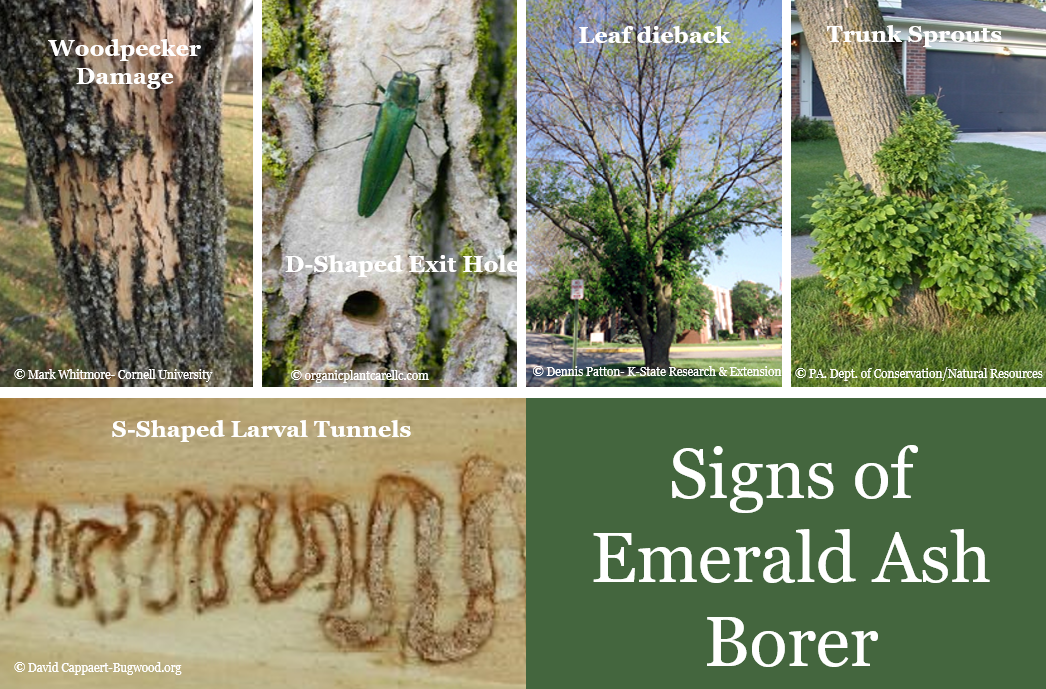Tree Borer Damage and Control in Springfield, Missouri
Signs of the Emerald Ash Borer

Protecting Trees Through Life Cycle Awareness and Preventive Care
At Imagination Landscapes, we understand how destructive tree borers can be to the health and longevity of trees across Springfield, Missouri. These pests burrow beneath bark, disrupting the flow of nutrients and water while weakening a tree’s structure. Over time, infestations can lead to branch dieback, canopy thinning, and even tree loss if left untreated. By focusing on the life cycle of borers—from egg to larva, pupa, and adult—we are able to identify vulnerabilities and apply treatments with precision.
Our team has several years of experience in diagnosing infestations, implementing effective control measures, and strengthening trees against future damage. We use professional techniques and preventative strategies designed to fit the needs of both residential and commercial landscapes. By combining early detection with proactive care, we help property owners preserve the value, beauty, and resilience of their landscapes against ongoing threats from tree borers.
Life Cycle of a Tree Borer
The life cycle of a tree borer, which refers to various species of beetles (e.g., Emerald Ash Borer, Bronze Birch Borer) or Moths (e.g., Clearwing Moths) whose larvae bore into trees, typically follows four stages: egg, larva, pupa, and adult. Below is a general overview, as specifics vary by species.
Egg Stage:
- Adult female borers lay eggs on the bark of host trees, often in crevices or under bark scales.
- Duration: A few days to two weeks, depending on species and environmental conditions (e.g., temperature).
Larva Stage:
- Larvae hatch and bore into the tree, feeding on the inner bark, phloem, or xylem, which disrupts nutrient and water transport.
- This is the most damaging stage, as larvae create tunnels (galleries) under the bark or in the wood.
- Duration: Several months to 1–2 years, depending on species, climate, and tree health. Some borers overwinter as larvae.
Pupa Stage:
- Larvae pupate within the tree or in the soil (depending on species) after reaching maturity.
- The pupa is a transitional, non-feeding stage where the insect transforms into an adult.
- Duration: A few weeks to a month, often in spring or early summer.
Adult Stage:
- Adults emerge from the tree, leaving characteristic exit holes (e.g., D-shaped for emerald ash borer).
- Adults are typically short-lived, focusing on mating and laying eggs. Some feed lightly on leaves or bark, but most damage is done by larvae.
- Duration: A few weeks, typically in warmer months (late spring to summer).
Environmental Factors such as temperature, tree species, and overall tree health influence the life cycle duration. Stressed or weakened trees are more susceptible to borer infestations.
Call or contact Imagination Landscapes at the form below to schedule an evaluation for your trees now. We schedule our systemic drench applications in the spring of each year when the trees begin breaking dormancy. This is the time of year when the sap is rushing up the tree to push out new growth for the season. Our systemic drench is applied at the base roots of the tree and is carried up with the sap thereby killing the borers inside. As a bonus this systemic drench protects your tree for an entire year and feeds your tree as well.
